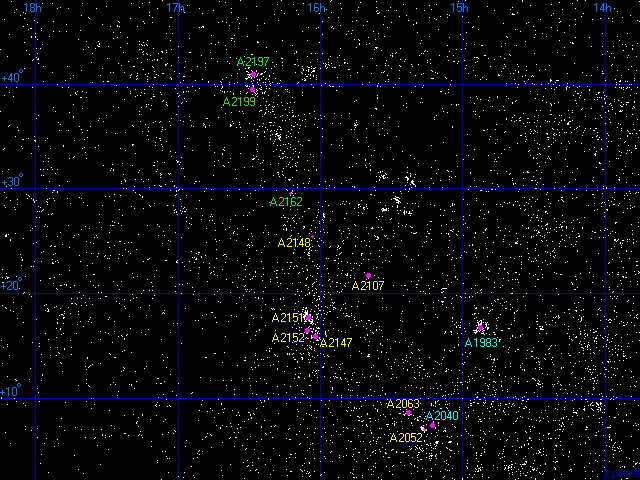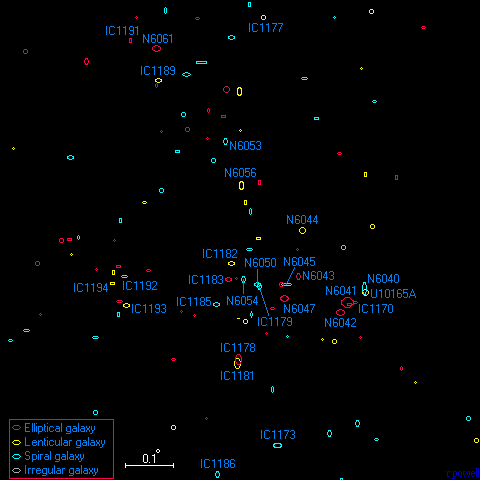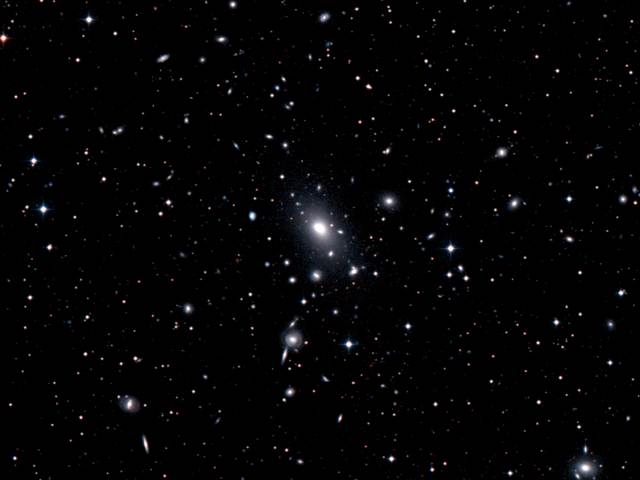
The superclusters in Hercules are famous superclusters. This plot of galaxies (from the Principal Galaxies Catalogue) shows the two superclusters.The northern supercluster at a distance of 400 million light years is dominated by the A2197/A2199 pair of clusters. Slightly further away at a distance of 500 million light years is the larger southern supercluster dominated by the clusters A2147, A2151 and A2152. Both superclusters are connected to each other and are sometimes referred to as a single supercluster.

Below is a list of the major clusters of galaxies in the Hercules Superclusters. The richest cluster is the A2151 cluster which is sometimes called the Hercules cluster. A2199 which is the nearest of all these clusters is also very rich as well. Two of these clusters - A1983 and A2040 - are at the back of the supercluster but may also be member clusters as well.
1 2 3 4 5 6 7
Abell Equatorial Redshift Distance Rich Notes
Number Coordinates z Mly
RA Dec
A1983 14 52.7 +16 45 .0424 580 1 background cluster
A2040 15 12.8 +07 26 .0448 610 1 background cluster
A2052 15 16.8 +07 00 .0338 465 0
A2063 15 23.0 +08 38 .0341 470 1
A2107 15 39.8 +21 46 .0399 545 1
A2147 16 02.3 +15 54 .0338 465 1
A2148 16 03.3 +25 28 .0418 570 0
A2151 16 05.2 +17 45 .0354 485 2 Hercules cluster
A2152 16 05.4 +16 27 .0398 545 1
A2162 16 12.5 +29 32 .0310 425 0
A2197 16 28.2 +40 54 .0296 405 1
A2199 16 28.6 +39 31 .0287 395 2
|
Column 1: The name/number of the cluster or group.
Column 2: The Right Ascension for epoch 2000.
Column 3: The Declination for epoch 2000.
Column 4: The redshift of the cluster.
Column 5: The distance in millions of light years assuming H=70km/s/Mpc.
Column 6: The 'richness' class of the cluster.
Column 7: Additional names and notes.
References:
Abell G, Corwin H, Olowin R, (1989), A catalogue of Rich Clusters of Galaxies,
Astrophys J Supp, 70, 1.
Struble M, Rood H, (1999), A compilation of redshifts and velocity dispersions for
ACO clusters, Astrophys J, 125, 35.
The Hercules cluster, A2151, is the richest cluster in the Hercules supercluster. Photographs of this cluster often appear in books because it contains some large spiral galaxies as well as the elliptical and lenticular galaxies usually found in rich clusters. There are no giant elliptical galaxies which are often found at the centre of very rich clusters.


This is a map of the Hercules cluster. This map shows 115 of the brightest galaxies in the central one degree area of the cluster. This is an interesting cluster because it contains a wide variety of different galaxy types. It is quite likely that this cluster consists of several smaller clusters that are merging together.
The first person who was aware of the superclusters in Hercules was probably Harlow Shapley in the 1930's. He noticed the cluster pair A2197/A2199 and the three clusters A2147, A2151 and A2152. For example, in a lecture published in 1934, Harlow Shapley published a map. The top cluster on his map is A2151 and the bottom cluster is a combination of A2147 and A2152.
It was not until the 1970's that other astronomers also realised that there were superclusters here. Massimo Tarenghi in 1976, while studying the A2151 cluster, suggested that it was part of a supercluster. At a conference about the Large Scale Structure of the Universe in Estonia in 1977, he presented evidence with W Tifft, G Chincarini, H Rood and L Thompson that this was a supercluster. Later in 1979 and 1980 they published a more detailed analysis of the supercluster in two papers (1, 2). This is their map produced 45 years after Harlow Shapley published his map.
In a paper published in 1981, G Chincarini, H Rood and L Thompson showed that the southern supercluster was linked to the northern supercluster by a wall of galaxies. S Gregory and L Thompson published an analysis of the northern supercluster in a paper in 1984.

Above - a picture of A2199, another rich cluster of galaxies in the Hercules supercluster. Like a lot of very rich clusters it has an enormous elliptical galaxy at the centre of it (formed by the merger of many smaller galaxies). This galaxy is NGC 6166.